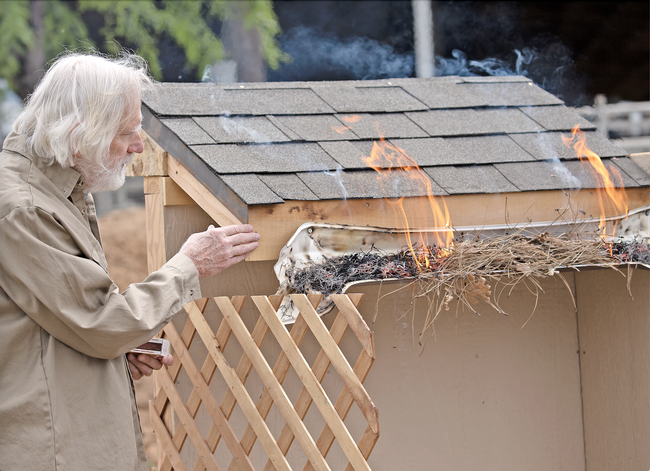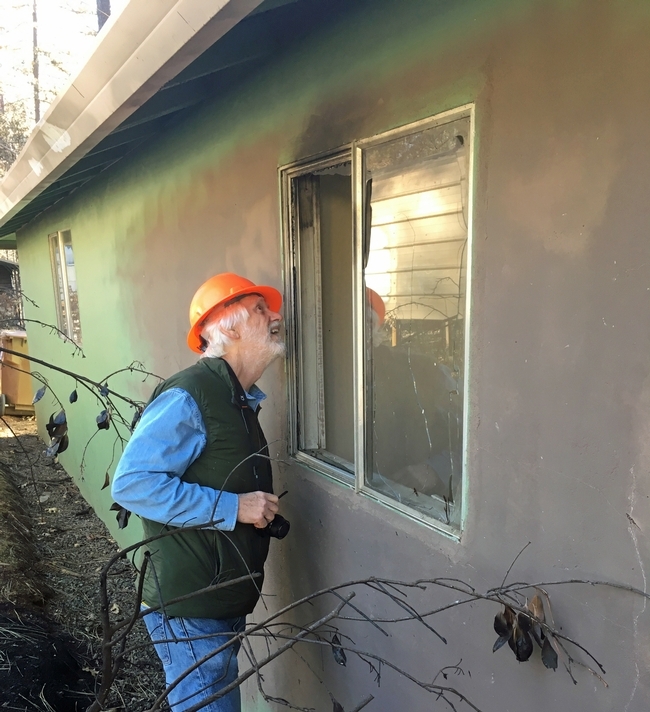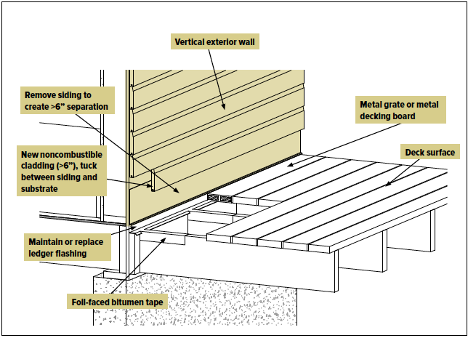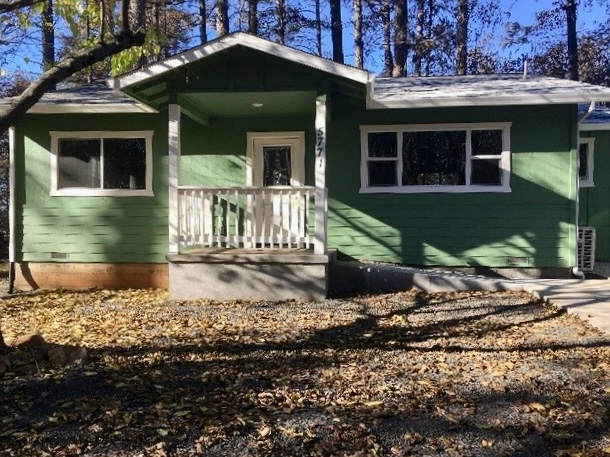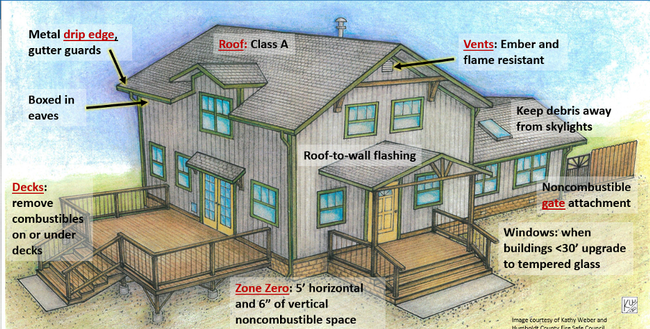Posts Tagged: Yana Valachovic
Report: Making homes more resistant to wildfire can be affordable
Priorities include removing objects within five feet of a house, upgrading vents
Wildfire losses cost taxpayers and communities hundreds of billions of dollars each year, and preparing communities before a disaster occurs is the best way to avoid damage to homes and neighborhoods. Retrofitting existing homes can make communities safer while avoiding billions in disaster costs.
As Californians learn to live with wildfire, scientists encourage improving the structure and design of houses and other buildings to help them survive wildfire. A new report shows that even inexpensive changes can increase wildfire resistance.
“Retrofitting a Home for Wildfire Resistance” suggests that some of the most effective strategies to reduce the vulnerability of homes and neighborhoods to wildfire can be done affordably.
“This report is a practical tool that helps evaluate the relative costs and benefits of fire-hardening retrofits,” said Yana Valachovic, a University of California Cooperative Extension forest advisor, who reviewed the study. “These retrofits can substantially improve the odds that a home or building will withstand wildfire exposures to embers, radiant heat or flame contact.”
The report is co-authored by Kimiko Barrett, wildfire research and policy analyst for Headwaters Economics, a non-partisan research organization based in Bozeman, Montana, and Stephen L. Quarles, UC Cooperative Extension advisor emeritus, who has studied the vulnerability of the built environment to wildfire exposures and potential mitigation strategies.
In partnership with California's Department of Forestry and Fire Protection, or CAL FIRE, Barrett and Quarles examined the costs for improving the structure and design of existing homes to increase their wildfire resistance.
“This tool can also help homeowners build a budget and prioritize tasks that often feel overwhelming,” Valachovic said. “Everyone should prioritize removing combustible vegetation, mulch, and stored materials within the first five feet of a structure and upgrading vents to resist embers.”
Simple actions can reduce a home's vulnerability to wildfire
The report's conclusions are derived from a detailed examination of the latest available science on mitigation strategies and construction costs. The authors identified costs for retrofitting structures to meet and exceed California's building code (Chapter 7A) for wildfire resistance, but the general principles and conclusions can be applied in other states, adjusting for local economic and supply conditions.
For a typical 2,000-square-foot home in California, retrofitting costs can range from $2,000 to upwards of $100,000 for the highest level of protection.
“When we looked at the latest building techniques and cost data, we found some effective retrofitting strategies can be done for between $2,000 to $10,000,” said Barrett. “While the highest level of protection can cost more, it is often not necessary. Simple actions such as removing flammable materials from near the home and removing debris from the roof can be done at little to no cost.”
The authors also incorporated effective mitigation strategies that could reduce risk without requiring costly upgrades over the entire home, such as replacing siding only on the side of a home that is close to another building, such as neighbor's home or a detached garage, or replacing combustible deck boards next to the home with a noncombustible deck board or metal grate.
They also incorporated a systems approach, where the vulnerability of adjacent components are considered, and recommend steps such as placing noncombustible surfaces at the intersection between two components.
For example, Quarles said: “Adding a gutter cover and ensuring the adjacent edge of roof is not vulnerable by incorporating a metal drip edge and, if necessary, a noncombustible bird stop at the edge of the roof. Or, replacing a combustible deck board next to the house and, if necessary, adding metal flashing at the base of the exterior wall.”
Cost estimates in the report include those for upgrading a home's exterior walls, roof, deck, windows, doors, eaves, gutters and near-home landscaping – all areas likely to be exposed to embers, direct flames and radiant heat.
“The graphics detailing specific elements of the retrofitting process are very useful,” Valachovic said.
Charts, architectural renderings and a detailed appendix of cost estimates provide a basis for a general understanding of the methods and budgets that homeowners might consider when retrofitting their home for wildfire resistance.
Retrofitting for wildfire can make communities safer
Contractors and others seeking information about building wildfire-resistant homes can gain valuable insights from this analysis, along with retrofit costs generated by the California Wildfire Mitigation Program.
“This analysis demonstrates that investing in wildfire-resistant retrofitting for homes is a cost-effective strategy to protect communities that could save billions in disaster costs,” said Barrett. “As more people live in fire-prone areas, we must also take a closer look at retrofitting homes to be stronger and more durable.”
While the authors hope Californians use the information to protect their homes, people who work in construction, development, design and policy also can use the information to show that retrofitting homes for wildfire resistance is an effective way to protect communities.
This 58-page report received funding from CAL FIRE and the U.S. Forest Service and can be downloaded for free at https://headwaterseconomics.org/wp-content/uploads/2024/06/Wildfire_Retrofit_Report_20240624.pdf.
Lawn-pocalypse! Surviving Drought
Ah, summer! The season of sunburns, pool parties, and… lawn droughts. If your once lush, green carpet now looks like a crunchy brown doormat, you're not alone. Let's dive into why your yard is staging a dramatic death scene and what you can do to...

Bermuda grass and weeds overtaking drought stressed turf grass.
How can we navigate changes in the home insurance market?
A wildfire shockwave recently hit California. Maybe you missed it. While there were no large wildfires threatening homes, and the air wasn't thick with smoke like in the Northeast from the wildfires in Canada, a shockwave did hit.
State Farm, California's largest home insurance company, issued an emergency declaration. As I write this, I note that my homeowner's policy is with State Farm, and while this may not affect me today, it could affect me when I choose to sell my home or buy a new one.
State Farm announced they will stop issuing new home insurance policies. Allstate issued a similar policy last year. These actions, in essence, shrink the available pool of insurers in California and are a very troubling sign for all of us. Furthermore, this action may significantly lengthen the time it takes to sell or buy a home in California or may affect our long-term ability to sell in the future and capture the financial values we have in our properties.
The loss of over 43,000 structures to wildfire over the last 10 years has not gone unnoticed by the insurance industry. Increasing fire hazards and skyrocketing costs to rebuild has everyone on notice that business-as-usual is not working.
California's policymakers and the Insurance Commissioner have their hands full with structuring the insurance market, creating a market that manages risk and attracts a diversified pool of insurance carriers, stabilizing insurance availability and affordability, and supporting the real estate sector of California's economy.
As a member of the state's Risk Modeling Workgroup, I can tell you that many approaches are being debated to address our challenges, including 1) allowing reinsurance calculations to be a part of insurance rates, 2) finding other ways to fund the Fair Plan (California's insurance plan of last resort), and 3) allowing catastrophe models to forecast risk in order to better anticipate future losses. With the passage of Proposition 103 in 1988, rate setting has been driven by past claims experience. Most suggest that future losses are likely to be significantly worse than past losses.
On July 13, the California Insurance Commissioner will hold a public hearing on whether rates should utilize catastrophe models that can account for anticipated climate changes and risk mitigation actions taken by property owners. Further, the state's Risk Modeling Workgroup will issue a report on this topic later this summer.
While these approaches are nuanced and complicated to understand, there are many actions that property owners can take to protect the value of their properties and mitigate risks.
Given this period of insurance instability, the best action property owners can take is to understand and mitigate wildfire risks. Reducing fuels, improving defensible space, and hardening the exterior of their structures to heat, flame and ember exposures will help to entice insurance companies to underwrite your property, enhance the ability to sell the property, and improve the odds of the building surviving future wildfires. By marketing the value of these actions, just like the remodeled kitchen or other property upgrades that attract homebuyers, you can market your asset to future insurance companies and buyers. Proactive actions, like upgrading vents, are a key part of the solution.
AB 38 (2019) started this process by mandating that the seller of a property disclose to the future buyer defensible space actions that have occurred for properties in Very High and High Fire Hazard Severity Zones. In 2025, these disclosures need to include home hardening actions based on an established low-cost retrofit list. Over time, these actions are likely going to become key for the negotiation of price and potentially the closure of the sale.
Independent assessment of preventive actions may also be helpful. The Safer From Wildfires program was established in 2023 to help promote insurance discounts for the voluntary adoption of wildfire mitigation actions; in my opinion, it could be used as an insurability assessment as well. Another option is to consider the Insurance Institute for Business and Home Safety's Wildfire Prepared Home designation. Helping your community think through the issues and take collective action to meet a Firewise designation is another approach to consider.
More information about home hardening and defensible space can be found at UC Cooperative Extension's Fire website. And if you need help navigating a recent insurance cancellation, United Policyholders, a consumer rights advocacy organization, has helpful resources.
Wildfire adaptation will not occur overnight, but I believe we have a pathway and clear evidence to demonstrate that these types of specific actions will help all of us live successfully with wildfire in California now and into the future.
Climate-Change Resources
University of California UC ANR Green Blog (Climate Change and Other Topics) https://ucanr.edu/blogs/Green/index.cfm?tagname=climate%20change (full index)
Examples:
- Save Trees First: Tips to Keep Them Alive Under Drought https://ucanr.edu/b/~CdD
- Landscaping with Fire Exposure in Mind: https://ucanr.edu/b/~G4D
- Cities in California Inland Areas Must Make Street Tree Changes to adapt to Future Climate https://ucanr.edu/b/~oF7
Drought, Climate Change and California Water Management Ted Grantham, UC Cooperative Extension specialist (23 minutes) https://youtu.be/dlimj75Wn9Q
Climate Variability and Change: Trends and Impacts on CA Agriculture Tapan Pathak, UC Cooperative Extension specialist (24 minutes) https://youtu.be/bIHI0yqqQJc
California Institute for Water Resources (links to blogs, talks, podcasts, water experts, etc.) https://ciwr.ucanr.edu/California_Drought_Expertise/
UC ANR Wildfire Resources (publications, videos, etc.) https://ucanr.edu/News/For_the_media/Press_kits/Wildfire/ (main website)
-UC ANR Fire Resources and Information https://ucanr.edu/sites/fire/ (main website)
-Preparing Home Landscaping https://ucanr.edu/sites/fire/Prepare/Landscaping/
UC ANR Free Publications https://anrcatalog.ucanr.edu/ (main website)
- Benefits of Plants to Humans and Urban Ecosystems: https://anrcatalog.ucanr.edu/pdf/8726.pdf
-Keeping Plants Alive Under Drought and Water Restrictions (English version) https://anrcatalog.ucanr.edu/pdf/8553.pdf
(Spanish version) https://anrcatalog.ucanr.edu/pdf/8628.pdf
- Use of Graywater in Urban Landscapes https://anrcatalog.ucanr.edu/pdf/8536.pdf
- Sustainable Landscaping in California https://anrcatalog.ucanr.edu/pdf/8504.pdf
Other (Non-UC) Climate Change Resources
Urban Forests and Climate Change. Urban forests play an important role in climate change mitigation and adaptation. Active stewardship of a community's forestry assets can strengthen local resilience to climate change while creating more sustainable and desirable places to live. https://www.fs.usda.gov/ccrc/topics/urban-forests
Examining the Viability of Planting Trees to Mitigate Climate Change (plausible at the forest level) https://climate.nasa.gov/news/2927/examining-the-viability-of-planting-trees-to-help-mitigate-climate-change/
Reports and other information resources coordinated under the auspices of the United Nations and produced through the collaboration of thousands of international scientists to provide a clear and up to date view of the current state of scientific knowledge relevant to climate change. United Nations Climate Action
Scientific reports, programs, action movements and events related to climate change. National Center for Atmospheric Research (National Science Foundation)
Find useful reports, program information and other documents resulting from federally funded research and development into the behavior of the atmosphere and related physical, biological and social systems. Search and find climate data from prehistory through to an hour ago in the world's largest climate data archive. (Formerly the "Climatic Data Center") National Centers for Environmental Information (NOAA)
Think tank providing information, analysis, policy and solution development for addressing climate change and energy issues (formerly known as the: "Pew Center on Global Climate Change"). Center for Climate & Energy Solutions (C2ES)
Mapping Resilience: A Blueprint for Thriving in the Face of Climate Disaster. The Climate Adaptation Knowledge Exchange (CAKE) was launched in July 2010 and is managed by EcoAdapt, a non-profit with a singular mission: to create a robust future in the face of climate change by bringing together diverse players to reshape planning and management in response to rapid climate change. https://www.cakex.org/documents/mapping-resilience-blueprint-thriving-face-climate-disaster
Cal-Adapt provides a way to explore peer-reviewed data that portrays how climate change might affect California at the state and local level. We make this data available through downloads, visualizations, and the Cal-Adapt API for your research, outreach, and adaptation planning needs. Cal-Adapt is a collaboration between state agency funding programs, university and private sector researchers https://cal-adapt.org/
Find reports, maps, data and other resources produced through a confederation of the research arms of 13 Federal departments and agencies that carry out research and develop and maintain capabilities that support the Nation's response to global change. Global Change (U.S. Global Change Research Program)
The Pacific Institute is a global water think tank that combines science-based thought leadership with active outreach to influence local, national, and international efforts to develop sustainable water policies. https://pacinst.org/our-approach/
Making equity real in climate adaptation and community resilience policies and programs: a guidebook. https://greenlining.org/publications/2019/making-equity-real-in-climate-adaption-and-community-resilience-policies-and-programs-a-guidebook/
Quarterly CA Climate Updates and CA Drought Monitor Maps (updated each Thursday) https://www.drought.gov/documents/quarterly-climate-impacts-and-outlook-western-region-june-2022
Drought focus of Water Resources IMPACT magazine special issue
UC ANR experts address emotional toll of drought
Preparing the American West for prolonged drought is the focus of a double issue of Water Resources IMPACT magazine. The California Water Commission staff are guest editors for this special open-access edition of the magazine, which is published by the American Water Resources Association.
Faith Kearns, academic coordinator of University of California Agriculture and Natural Resources' California Institute for Water Resources, is among the authors delving into how drought impacts people and the environment and how we can better prepare for the inevitable.
The first issue, published on Feb. 14, focuses on water scarcity issues confronting California and the ways these issues affect different sectors.
In “Trauma, Care, and Solidarity: Addressing the Emotional Toll of Chronic Drought,” Kearns highlights the effects of drought on mental health. She points to the spike in suicide hotline calls when wells ran dry in Southeast Asian communities in California's Central Valley.
By listening to Southeast Asian farmers, Ruth Dahlquist-Willard and Michael Yang of UC Cooperative Extension were able to “lighten the load” for them by providing pragmatic support, Kearns writes.
“The scale of some of these highly emotional issues – drought, wildfires, climate change – can make them seem incredibly difficult, if not impossible, to deal with,” Kearns said. “At the same time, they are affecting everyone living in the western U.S. on a daily basis. I wanted to highlight and provide models based on work that people – whether they are researchers, clinical psychologists, or Cooperative Extension advisors – are doing right now to ease the way.”
The authors who contributed to the double issue are a diverse array of Tribal experts, academics, nongovernmental organization thought-leaders, water managers and water policy influencers, each of whom brings their own perspective on the topic of drought. Their expertise and perspectives in climate science, water policy and water management will help inform drought-related decision-making and support policies that better prepare the state to thrive during periods of prolonged water scarcity.
In addition to Kearns, the first issue includes articles contributed by:
- Samantha Stevenson, University of California, Santa Barbara
- Jay Lund, University of California, Davis
- Ron Goode, North Fork Mono Tribe
- Andy Fecko, Placer County Water Agency
- Jeff Mount, Public Policy Institute of California, and Ted Grantham, University of California, Berkeley/UC Cooperative Extension
- Nat Seavy and Karyn Stockdale, National Audubon Society
- Kjia Rivers, Community Water Center
- Cannon Michael, Bowles Farming
- Michelle Reimers, Turlock Irrigation District
The January/February edition of Water Resources IMPACT magazine can be accessed, free of charge, on the American Water Resources Association website at https://www.awra.org under “Publications.”
The second issue, to be published in March, will focus on drought response, considering the options for adaptation. This two-part series complements the Commission's work on strategies to protect communities and fish and wildlife in the event of a long-term drought.

